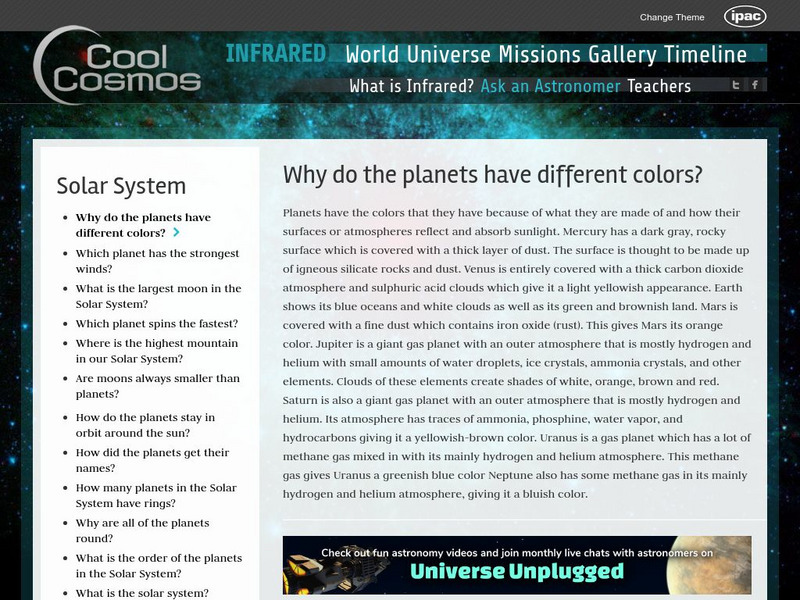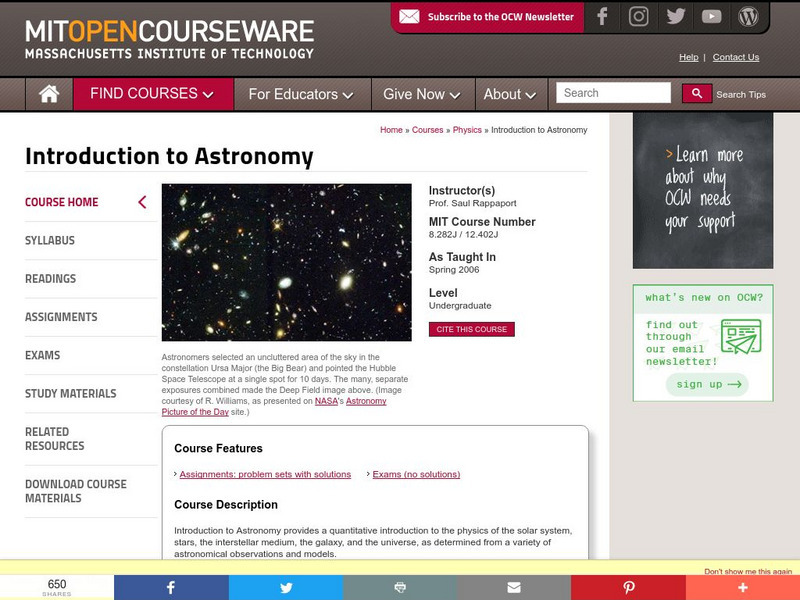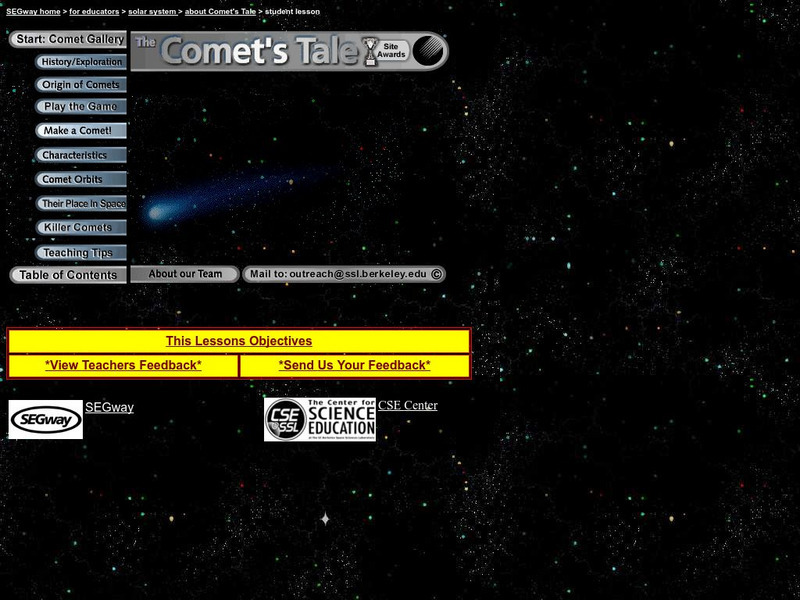Hi, what do you want to do?
Curated OER
Space: The Final Frontier
Sixth graders construct a graph to demonstration information that they've learned about the solary system. They also write or illustrate a sonar or lunar eclipse.
Curated OER
Our Solar System: Its Planets and Their Satellites
Fourth graders create a replica of our solar system. Each group arranges the balls in the proper order for our solar system by gluing them to the construction paper. Under each of the balls, the name of the object should be clearly printed.
Curated OER
Space - In Your Face or Not?
Second graders, in groups, examine how it doesn't matter if they can see the planets in the solar system or not--they're there.
Curated OER
Out of This World (Language Arts)
Second graders, in groups, research the planets in the solar system and create a guidebook for travel.
Curated OER
Science - Lesson 42 - Astronomy
Third graders demonstrate the position of the Earth, Moon, and Sun in a solar and lunar eclipse. They list uses for manmade satellites and write a description of how a satellite would be use.
Curated OER
Sunscapes
Students share their observations of the Sun, then analyze images collected by NASA's Solar and Heliospheric Observatory. They create exhibitions for presentations.
Curated OER
The Path of the Sun: The Ecliptic
Students investigate the celestial sphere and the paths it takes in the solar system.
Curated OER
The Discovery of the Solar System
Students explain the observed motion of the planets. The inner ones move back-and-forth across the position of the Sun, while the outer ones usually advance in one direction, but with occasional temporary reversals known as "retrograde...
Curated OER
May The Earth Be Revolving Around The Sun?
High schoolers trace the beginning of the heliocentric theory of the solar system--the idea that the solar system revolves around the Sun--to an observation by the Greek astronomer Aristarchus, which convinced him that the Sun was much...
Curated OER
Planetary Research (Grades 9-12)
High schoolers are introduced to planetary research and familiarize them with the planets and their features. They see that each planet has unique features. Planets have some common features and that images can be used to study the...
Curated OER
Bouncing Sunlight
Third graders use flashlights and balls to demonstrate how the light bounces off of the sun and reflects onto the moon. They record their observations in a journal.
Curated OER
Outer Space and Cyber Space
Fourth graders learn about the Solar System while they use mean, median and mode to explore the characteristics of the planets. Students web publish expository writing.
Curated OER
Earth's Orbit Lesson
Tenth graders devise a computational model to explore how the orbit of the Earth might change if its velocity were different. Using accurately recorded data, 10th graders defend a scientific argument.
Curated OER
Planet/Constellation Mobile
Pupils, through small group discussion, identify and share a rationale for shapes and patterns in the construction of a mobile that represents the solar system that makes them think of the creation of our solar system.
California Institute of Technology
Cool Cosmos: Ask an Astronomer
Resource compiles a list of most frequently asked questions about Mercury. Each question is linked to an astronomer's answer. Kids can explore many aspects of this wonderful planet.
California Institute of Technology
Cool Cosmos: Ask an Astronomer: Venus
Resource offers the answers to many frequently asked questions about Venus. Kids can click on the user-friendly question links to learn more about this amazing planet.
California Institute of Technology
Cool Cosmos: Ask an Astronomer
Cool Cosmos and NASA have joined together to provide kids with the answers to their most frequently asked questions. Visit this site to learn more about asteroids.
California Institute of Technology
Cool Cosmos: Ask an Astronomer for Kids: Solar System
Resource presents information about the solar system through a list of most frequently asked questions. Click on each question and be transported to a wealth of knowledge about our solar system and the planets within it.
California Institute of Technology
Cool Cosmos: Ask an Astronomer
Cool Cosmos and NASA help you uncover the mysterious Nebula. Kid's frequently asked questions are answered on this site thorugh easy to use links!
Exploratorium
Exploratorium: A Guide to Astronomy Resources
A portal to resources on the sun, the Earth's neighboring planets, and the weather in space. Find out why Saturn is the "jewel of the Solar System" and explore what happens when Venus and Mercury make their rare transits across the sun.
Massachusetts Institute of Technology
Mit: Open Course Ware: Courses: Physics: Introduction to Astronomy
A university-level introduction to basic astronomy. Includes course readings, assignments, exams, and study notes with links to images and to biographical profiles of famous astronomers.
Massachusetts Institute of Technology
Mit: Open Course Ware: Earth, Atmospheric and Planetary Sciences: Solar System
A university-level course that looks at the structure of the solar system, the sun, the planets, and other bodies in space. Includes course readings, assignments, and study notes.
PBS
Pbs Learning Media: All Planet Sizes
This illustration from the Lunar and Planetary Laboratory shows the approximate sizes of the planets relative to each other. Note that the planets are not shown at appropriate distances from the Sun.
University of California
Univ. Of Cal Berkeley: The Comet's Tale
Site provides extensive information in the study of comets. Includes excellent graphics that depict what comets look like as they travel through the solar system. Also includes information on how comets may have effected the Earth's...




























